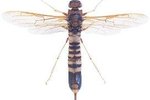
Armed with some of the world’s most powerful venom, bullet ant workers live their lives collecting food, defending their nests and tending to their colonies' young, while the queen -- securely sequestered below ground -- spends her life producing eggs. Bullet ant colonies are somewhat small, usually consisting of only a few thousand individuals.
Bullet Ant Biology
Bullet ants reach about 1 inch in length and are usually dark red to black. They are primarily scavengers and predators, foraging for nectar and hunting invertebrates and, occasionally, small vertebrates. Bullet ants have relatively large stingers and powerful venom. Bullet ants sting their prey before bringing it back to the nest, but they will also use their stingers defensively. The venom of bullet ants is painful for mammals -- bullet ants have the most painful sting of any insect known to science.
Nests
At maturity, lone queens set out to establish new nests. Most queens usually seek to locate their nests at the bottom of tall trees or vines so workers will be able to reach the canopy conveniently. Sometimes, they construct nests directly in tree hollows. The nests, which sometimes extend more than 2 feet below the surface, have numerous flat-floored chambers with slightly domed ceilings. One nest investigated in 1983 had 43 separate chambers.
Social Organization
Bullet ants are primitively eusocial; an internal hierarchy exists, but workers are only slightly smaller than the queens. The worker caste exhibits division of labor -- smaller individuals stay inside the nest and tend to the queen and her eggs, while larger individuals forage and defend the nest. Only mature colonies produce winged males and virgin female queens. If their nest is attacked by a predator, the workers will rush to the entrance to defend the colony. Sometimes, bullet ants in mass produce a loud buzzing sound when trying to deter a predator.
Life Cycle
Queens produce all of the colony’s eggs. Because of the danger involved in working with the animals, little is known about their reproductive habits in the wild. Bullet ants go through complete metamorphosis -- eggs hatch into larvae, which eventually pupate before turning into adults. In captivity, bullet ants will nest in crevices. Though the eggs, larvae and pupae develop normally when kept at uniform temperatures, scientists have observed ants moving large larvae and pupae to the warmest parts of the nest, which speeds their development slightly.
References
Photo Credits
-
Stockbyte/Stockbyte/Getty Images



